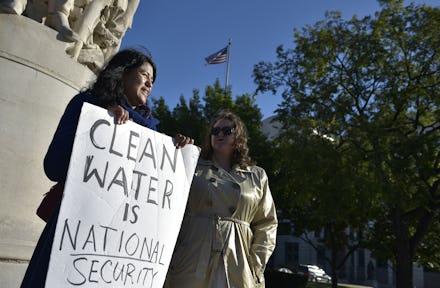Could the Dakota Access Pipeline leak? Expert says government has underestimated the risk

An independent expert hired by the Sioux tribe released the results of a study on Thursday showing the U.S. government underestimated the possible risk of an oil spill resulting from the Dakota Access Pipeline, as well as other potential problems with the project.
"I have concluded the EA (environmental assessment) is seriously deficient and cannot support the finding of no sufficient impact, even with the proposed mitigations," Richard Kuprewicz, president of Accufacts Inc., a safety firm in Redmond, Washington, that advises government agencies and industry about pipelines, says in the report. "The analysis is incomplete such that potential risks and impacts to the federal areas have not been adequately presented nor evaluated."
Besides underestimating the risk of an oil spill into sensitive areas, the report documents:
1. Poor quality pipeline construction
Standing Rock Sioux Tribe chairman Dave Archambault II urged the Army Corps of Engineers, the group in charge of the pipeline, to take into account this new information and to reassess their conclusion that the project would have no effect on the Reservation's inhabitants. The tribe has called for a halt in construction pending further review. Mic reached out to the Army Corps of Engineers but has not heard back.
"This underscores one of the fundamental deficiencies of the Final Environmental Assessment — it assumes, without foundation, that placing a massive oil pipeline just upstream from the Reservation presents no risk to the Tribe," Archambault wrote in a letter to Assistant Secretary of the Army (Civil Works) Jo-Ellen Darcy. Darcy supervises all functions related to the Army Corps of Engineers Civil Works program.
The Dakota Access Pipeline is a 1,172-mile, $3.7 billion project that would transport around 470,000 barrels of crude oil daily from the Bakken oil field in North Dakota to a refinery in Patoka, Illinois. The pipeline, which will run through four states, is slated to run under the Missouri River, the longest river in the United States.
Protesters who call themselves "water protectors" say the project could contaminate the water supply for area residents and others downstream. For members of the Standing Rock Lakota Sioux Nation, it could poison their sole source of drinking water. The proposed route also passes through burial grounds and other lands of historical significance to the tribe.
"The law requires a full and transparent analysis of risks like oil spills prior to issuance of a federal permit. It's clear that never happened here," said Jan Hasselman, who represents the Tribe in its litigation against the Corps. "We expect the Corps to give this new report close consideration as it determines whether to move ahead with the permits needed to cross the Missouri River — permits that Dakota Access didn't have before starting construction of the pipeline."
The #NoDAPL movement appears to be gaining widespread support. Millions of people have "checked in" to the Standing Rock Indian Reservation on Facebook to support the Sioux. Although this didn't confound authorities the way many intended, the tribe nonetheless appreciated the expression of solidarity.
However, as the pipeline nears the Missouri River, clashes between police and protesters are escalating. On Wednesday, demonstrators were shot with rubber bullets and subjected to streams of pepper spray, following mass arrests on Oct. 27 when 141 activists were detained while protesting at the site.
"I have tried to convey the vital importance of the waters of Lake Oahe to the life of the tribe," Sioux chairman Archambault writes. "It is precisely because of our deep connection to these waters—in both practical and spiritual ways — that an oil spill from the Dakota Access Pipeline would be so devastating to us."